B ![]()
![]() p
p ![]() a
a![]() g
g![]() e
e![]() s
s![]()
![]() a
a![]() r
r ![]() e
e ![]()
![]() d
d![]() e
e![]() d
d![]() i
i![]() c
c![]() a
a![]() t
t![]() e
e![]() d
d ![]()
![]() t
t![]() o
o
J![]() e
e![]() f
f![]() f
f ![]()
![]() B
B![]() i
i![]() l
l![]() l
l![]() i
i![]() n
n![]() g
g![]() s
s
 black and white - See the section of Mark Harden's Artchive
in which he discusses the case for black & white.
black and white - See the section of Mark Harden's Artchive
in which he discusses the case for black & white.
Also see 1-bit image, charcoal, and photography.
black-figure - In ancient Greek pottery, a technique in which dark figures were silhouetted against a light background of natural, reddish clay.
Examples:

Greece, Attic, attributed to the Amasis Painter,
Lekythos, c. 550-530 BCE,
black-figure, terra cotta, height 6 3/4 inches (17.15 cm),
Metropolitan Museum of Art, NY. See lekythos.

Greece, Attic, attributed to Exekias, Neck-amphora with lid, c. 540 BCE,
Archaic, black-figure, terra cotta,
height 18 1/2 inches (46.99
cm), Metropolitan Museum of Art, NY. See amphora.
Also see red-figure, vase and vessel.
blanc de Chine - The Western name (from the French) for the Chinese porcelain made at Tê Hua (Dehua) in Fukien (Fujian) Province in southeast China from the seventeenth century (Ming Dynasty). Blanc de Chine is highly translucent and all-white — in many shades of white glaze, rarely with further decoration. Names for the various blanc de Chine whites include "ivory white," "goose-feather white," and "pork-fat white" (slightly pinkish). Most blanc de Chine is sculptural rather than utilitarian. There are many Buddhist deities and personalities, as well as animals, natural and mythical.
(pr. BLAHNK də-SHEEN)
Also see ivory.
bland - Without impact or strength. Bland art is too mild; insipid; banausic.
Also see academic, bad art, buckeye, calendar painting, edge, ennui, function, kitsch, low art, picturesque, and popular culture.
blanket - The felt or foam rubber used between the paper and the roller on an intaglio press. Also, a rubber-surfaced fabric used on the cylinder of an offset printing press.
Also see textile.
Blaue Reiter, Der - See Der Blaue Reiter.
Blaue Vier - German for "the blue four." An alliance formed in 1924 by four painters, Paul Klee (Swiss, 1879-1940), Wassily Kandinsky (Russian, 1866-1944), Lyonel Feininger (German-American, 1871-1956), and Alexei von Jawlensky (Russian, 1864-1941). They held exhibitions together in Germany, Mexico, and the United States.
Examples:
Wassily Kandinsky, Composition VIII, 1923, oil on canvas.
Wassily Kandinsky, Swinging, 1925, oil on board, 70.5 x 50.2 cm, Tate Gallery, London. Kandinsky's book Point and Line to Plane, published in 1926, explains the meanings he ascribed to the geometric imagery he put into such paintings as this.
Paul Klee, Pflanzenwachstum (Growth), 1921, oil on cardboard, 54 x 40 cm, Georges Pompidou Center, Paris.
Paul Klee, Historical Place, 1927, watercolor and ink on paper on card on board, 35.5 x 48.7 cm, Tate Gallery, London.
Paul Klee, Pfeil im Garten (Arrow in the Garden), 1929, oil and tempera on canvas, 70 x 50.2 cm, Georges Pompidou Center, Paris.
Also see Bauhaus, Der Blaue Reiter, Die Brücke, expression, and Expressionism.
blazen - See heraldry.
bleach-out - A bromide print that is underdeveloped, so that it can be used as the foundation of a line drawing, and then bleached away.
bleed - Pigments that run into an adjoining area or up through coats of paint, usually undesirably (see bleeding through and bleed-proof). A fuzziness or spreading at the edges of a painted area. And, in the graphic arts, to extend the edge of a printed area, leaving no margin at one or more edges of a page. This is done by printing an extra 1/8 inch of image area, to be trimmed later.
Also see bleed marks, permanent pigment, polymer clay, stain, and stain removal.
bleed marks - Lines at the corners of a piece of artwork to be reproduced. The extending area — the bleed (typically 1/8 inch) — can be seen outside of the bleed marks.
Also see crop and register marks.
bleeding through - In oil paints, degrees of visibility of underpainting when upper layers become translucent with the passage of time. Or, a color that doesn't set, but affects subsequent overlays. Also, ink on paper which stains the image beyond where it was intended.
Also see bleed and bleed-proof.
bleed-proof - Describes inks and paints that will not spread when wetted with water.
Also see bleed, fugitive colors, permanent pigment, polymer clay, solvent, and water-soluble.
blend - In artwork, to merge colors applied to a surface, whether with a brush, crayon, colored pencil, or other medium. This is sometimes called feathering.
Also see focus, gradation, sfumato, and shading.
blind arcade - In architecture, an arcade having no actual openings, applied as decoration to a wall surface. Also called a wall arcade.
blind continuous-line contour drawing - See contour drawing.
blind pressing - In printmaking, making an embossed print with an uninked plate. This is also called blind printing. When using an intaglio plate this is more specifically called either an inkless intaglio or a gypsographic print.
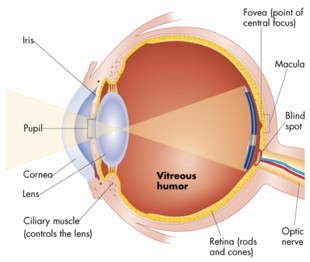 blind spot
- The area on the retina
without photoreceptors that
respond to light. An image
that falls on this region is not seen.
The optic nerve exits the retina at this location on its way to
the brain.
blind spot
- The area on the retina
without photoreceptors that
respond to light. An image
that falls on this region is not seen.
The optic nerve exits the retina at this location on its way to
the brain.
Related resources:
Also see afterimage, colorblindness, cross-section, gestalt, night blindness or nyctalopia, Op Art, optical, optical illusion, optical mixing, perception, peripheral vision, sight, stereoscopic vision, subliminal message or subliminal advertising, and visual qualities.
block - A body of material for carving. The term is also applied to a piece of material for block printing, or to wood used to beat and consolidate large masses of clay.
Also see blockbuster, blocking in, block out, blocks to creativity, and impost block.
blockbuster - Often used to refer to a thing expected to be hugely popular. The biggest exhibits at major museums are called blockbusters when they draw tremendous crowds. A landmark blockbuster exhibition was a show of objects from King Tut's tomb in the 1970s. The blockbusters since then have included exhibits on Impressionists, Post-Impressionists, Cubists, and the Imperial Tombs of China.
blocking in - Laying down the initial statement of a picture by a broad indication of line, color, and tone. After blocking in, artists typically develop their compositions from general to particular by ever-increasingly refining shapes, colors, textures, etc., until an artwork is finished.
Also see abbozzo, sketch, and study.
block out - In graphics, to stop out an area with tusche, shellac, stencil film, etc.
Also see blockout, lithography, printmaking, resist, serigraphy, and silkscreen.
blockout or block-out - A resist.
Also see block out.
block printing - Printing methods in which a block of wood, linoleum or some other material's surface is carved so that an image can be printed from it — uncarved areas receiving ink which transfers to another surface when the block is pressed against it. Also known as relief printing.
Also see brayer, chiaroscuro, and wallpaper.
blocks to creativity - Important to successful living, creativity is an essential component of an artist's productivity. Creativity can flourish when it is motivated. Blocks to creativity are things that can interfere with it. Here are blocks of two kinds: environmental and cultural.
|
Environmental blocks to creativity: 1 One's surroundings must provide space, furnishings, lighting, atmosphere, sound, odor, safety, and comforts of adequate quality. Outside people and things must not overly intrude. Examples of problematic surroundings: a roof that's leaking, air that's too hot or too cold, a relative or neighbor that's threatening or crying. 2 When a collaborative creative group is formed, an inflexible or inconsiderate member can sabotage the process. 3 When someone takes control of what ideas will be entertained, the ideas of others are frustrated. Establishing the roles of team members (the rules members are expected to follow) as early as possible is helpful. 4 Examples: Hunger, illness, and financial worries. Or, an educator, gallery, client, or grant-provider whose rigidity or negativity is obstructive. |
|
Cultural blocks to creativity: 1 When I doubt that I am capable of accomplishing a task successfully (whether this self-doubt is reasonable or not) it can be a self-fulfilling prophecy. Anticipation of failure easily breeds failure. When confidence-building is needed, here is how to do it: start with easy tasks, and proceed to gradually more and more challenging ones. Studies have proven that people can learn at any age, no matter what their experience or lack of experience has been. A creator takes much higher risks than does a critic. Indeed just a few harsh words can be devastating. Although we hope for rewards for doing things well, we are criticized for our flaws. "Everyone's a critic" is a cliche, but it's also true. The world is not always kind and understanding toward bold creativity. Negative criticism — ridicule and punishment — whether true or not, should be deflected. Constructive criticism is positive advice, such as suggestions of how to make improvements. It is both easier and wiser to attend to it. Indeed constructive criticism is vital to everyone's growth. Each of us needs to cultivate our skills of receiving and giving it. See art criticism and critique. 2 Key to the success of creative thinking is the ability to entertain widely differing or incongruous ideas, so that they can coexist long enough conceptually in order to be considered as a new composition. 3 This is the safer way to go. If a person analyzes a new idea too early in the creative process, new ideas are rejected before they have been allowed to take what might become more appealing forms. "We are each our own worst critics," is a related cliche, and likewise often true. Letting 4 Time is often needed for the subconscious to wrestle with a challenge. When a person is relaxed, he is more receptive to new ways of thinking about the challenge. 5 The attitude: "There's nothing in it for me." Or, "If there's no reward, why do it?" 6 The attitude: "I want it NOW!" Everyone likes instant gratification, but a creative person avoids requiring results prematurely. 7 The need to be awake, alert, present, attentive. The need to be able to fantasize, but not sink at the deep end. |
An obscure term for the fear of failure is "alychiphobia."
Quote:
Also see art criticism, art therapy, attitude, brainstorming, choose, culture, custom, effort, genius, inspiration, motivation, and muses.
bloom - A fine cloudy discoloration which forms, most commonly, on the surface of varnish, or on melted wax or concrete cast in a plaster mold.
Bloom's Taxonomy - A hierarchical list of thinking skills. The six levels of Bloom's taxonomy should be used in stating objectives of lessons and in devising questions which stimulate thinking at each level. The six levels, from lowest to highest, are: knowledge, comprehension, application, analysis, synthesis, and evaluation. Another level, some propose, is meta-cognition.
Also see cognitive, effort, interdisciplinary, and multiple intelligence theory.
blot - A spot or stain. This generally carries negative connotations, but can also be interpreted as advantageous — as an opportunity: whether accidental or intended. It may be made or accepted as an aleatoric act. As a verb, to blot can refer to spotting or staining, but it can also mean: to soak up with an absorbent material, such as a towel, sponge, or rag — an act of erasure. Blotting paper is manufactured to soak up excess ink. In painting, blotting is a means of removing paint, and a particularly important technique in watercolor painting.
Also see art conservation, blotto painting or inkblot, cleaning, Dada, detritus, dot, dye, pigment, point, solvent, subtractive, wash, and water-soluble.
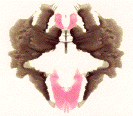 blotto painting - A painting made
by applying tempera paint
onto one side of
blotto painting - A painting made
by applying tempera paint
onto one side of  a
sheet of paper, then folding the paper
and pressing the two sides together. Like an inkblot,
a blotto painting is apt to be symmetrical
and nonobjective. Making one
is largely an aleatoric act — leaving
much to chance.
a
sheet of paper, then folding the paper
and pressing the two sides together. Like an inkblot,
a blotto painting is apt to be symmetrical
and nonobjective. Making one
is largely an aleatoric act — leaving
much to chance. An example. Also see Rorschach
test.
blow forming - A method of forming acrylic sheet. The plastic is heated until pliable, then clamped and subjected to a blast of air which inflates it like a balloon.
blowup or blow-up - An enlargement, also called a bump up. This term is most commonly used in photography.
Also see close-up, detail, field, field of view, point of view, telephoto, tracking shot, wide-angle, and zooming.
Blue Four - See Blaue Vier.
blue pencil - May refer to a pencil of a certain pale tone used to mark artwork and photographs because it does not reproduce on certain photographic films insensitive to blue. Such films are employed in preparations for some printing processes.
Blue Rider - See Der Blaue Reiter.
bluing - Coloring the surface of metal by applying concentrated heat from a blowtorch or oxyacetylene torch. Oxidation gives the metal a blue tinge. Also spelled blueing. There is a chemical solution available which also blues metal. [Can you tell us precisely what that is called?]
Example:

England, Royal Workshops, Greenwich, Armor of George Clifford, Third Earl of Cumberland,
c. 1580-85, steel, etched, blued,
and gilded, height
69 1/2 inches (176.5 cm), weight
60 pounds (27.2 kg), Metropolitan Museum of Art, NY. See arms & armor.
Also see patina.
board - May refer either to a piece of lumber or to a sturdy sheet of some other material, such as cardboard, Masonite, etc. May also refer to a billboard. Also see bristol board, matboard, oaktag, panel, and wood.
boasting - Dressing or shaping the surface of a stone block with a broad chisel.
Bodhisattva - In Buddhism, a Bodhisattva is one who has attained enlightenment, but chooses to remain among humankind to help others achieve it. A Bodhisattva is a being who is a potential Buddha.
(pr. BOH-dee-SOT-və)
Example images of Bodhisattvas:

Pakistan, ancient region of Gandhära,
Standing Bodhisattva, 1st-2nd century
CE,
Kushan period, gray schist,
59 1/8 x 30 x 10 inches (150.2 x 76.2 x 25.4 cm), Kimbell Art
Museum, Fort Worth, TX.

Pakistan, ancient region of Gandhära,
Torso of a Standing Bodhisattva, Kushan
period (c. late 1st-3rd century CE),
c. late 1st-2nd century, gray schist,
height 64 1/2 inches (163.8
cm), Metropolitan Museum of Art, NY.

Japan, Asuka period, Standing Bosatsu (Bodhisattva), 7th century.
See Bodhisattva.

China, Shenxi Provence, Seated Bhuddha with Attending Bodhisattvas,
Northern Wei dynasty, early
6th century, limestone with
polychrome, Worcester Art
Museum, MA. See Chinese
art.
![]()
Japanese, Heian
period, early 10th century, Juichimen Kannon (eleven-headed Kannon),
solid woodblock construction with traces of polychrome,
Worcester Art Museum, MA.

China, Mandala, 1330-1332, Yüan
dynasty, c. 1330-32, silk, metallic
thread, 96 5/8 x 82 1/4 inches (245.4 x 208.9 cm), Metropolitan
Museum of Art, NY. See mandala.
Also see Buddhist art and Chinese art.
body - A term used to refer to a mass of clay formed from a mixture of clays, or clay and ceramic materials.
Body Art or body art - An art form in which the artist's
body (aka wetware) is the medium.
A type of conceptual art which
was a precursor to performance
art, Body Art often took the form
of public or private performances, many of which became known
more widely through photographic
and textual documentation.
Among the Body artists at its height from the 1960s to about 1980
were Vito Acconci (American, 1939-), Chris Burden (American, 1946-),
and Ana Mendieta (Cuban-American, 1948-1985). Tattooing,
piercing, branding, scarification,
inplanting, and mehndi are
forms of body ![]()
![]() art, each
with contemporary manifestations, most with long traditions.
There are numerous serious health concerns associated with many
forms of body art.
art, each
with contemporary manifestations, most with long traditions.
There are numerous serious health concerns associated with many
forms of body art.
Also see cosmetic, costume, dance, and jewelry.
body color or bodycolor - An opaque paint. Transparent colors are often made opaque by mixing them with some gouache or some opaque white. Often considered synonymous with gouache. Body color has sometimes been used in local areas in drawings, and sometimes as a general medium.
Also see whiting.
An example of a work employing bodycolor:

Honoré-Victorin Daumier (French, 1808-1879),
A Criminal Case, c. 1860, watercolor and bodycolor,
with pen and brown ink
and black chalk, 15
1/8 x 12 13/16 inches (38.5 x 32.8 cm), J. Paul Getty Museum,
Malibu, CA.
bohemianism - Originally, the alternative lifestyle of the avant-garde creative community of the Romantic movement during the nineteenth century, especially characterized by anti-bourgeois and anti-intellectual attitude. This way of life was thought to have been similar to that of apparently rootless Gypsies from the Bohemian region of Czechoslovakia. This mythology continues to add luster to manners and values conspicuously different from those expected or approved by the majority of society.
Also see culture.
bokusaiga - In Japanese art tradition, an ink painting employing the traditional black color.
bokuseki - Japanese for "traces of ink." Zen Buddhist calligraphy.
bold - Strong, direct, distinct, conspicuous, and (sometimes) daring. In typography, used as a short form of boldface.
Also see emphasis.
boldface - In typography, a heavier version of a regular typeface.
bole - A fine clay used as a preparatory undercoat for gold leaf, its color affecting the appearance of the gold leaf placed upon it. Bole can be pale pink or dark grayish-blue or green, but it is usually an orange or red.
Also see frame, furniture, and semi-matt.
Bolognese school - A group of artists in and near Bologna, Italy from the twelfth to the seventeenth centuries.
Also see Gothic and Middle Ages.
bond paper - A good quality paper used for drawing and sketching.
bone china - English soft porcelain made with bone ash as a flux.
bone dry - In ceramics, greenware which is thoroughly room dried.
bone emulsion - A material which, when added to plaster or moist clay, makes it self-hardening.
boneless style - See mo-ku. [when the article on it is posted.]
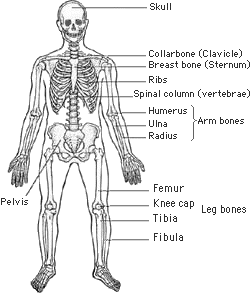
bone structure - The body frame. The way the bones effect the figure's surface appearance.
Also see anatomy, interdisciplinary, and science and art.
bonus ideas - May refer to artist's ideas or efforts which take a work above and beyond what would be accepted by the audience.
A quote about bonus ideas:
book of hours - A book for private devotions containing prayers for different hours of the day. Each book of hours is a a collection of texts for each liturgical hour of the day, along with other texts such as calendars, prayers, psalms and masses for holy days. Often these books were richly illustrated with illuminations. A classic book of hours is Les Tres Riches Heures, one of the great art treasures of France, the greatest achievement of the art of manuscript illumination. It was painted by Paul, Hermann and Jean Limbourg (brothers, Flemish, each c. 1380-1416), 1412-1416, for the very wealthy Duke of Berry, a brother to a king and other dukes. The Limbourgs used a variety of colors obtained from minerals, plants or chemicals, mixed with either gum arabic or gum acacia to provide a binder for the paint. Among the more unusual colors they used were vert de flambe, a green obtained from crushed flowers mixed with massicot, and azur d'outreme, an ultramarine made from crushed Middle Eastern lapis-lazuli, used to paint the intense blues, and extremely expensive. The fine detail which was characteristic of the Limbourgs demanded extremely fine brushes and, almost certainly, magnifying lenses.
Another example:
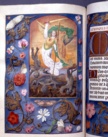
Master of the Old Prayerbook of Maximilian
I and Associates (Flemish, Ghent), The Hours of Queen Isabella of Spain,
c. 1497-1500, ink, tempera,
and gold on vellum, 8 7/8 x 6 inches (22.5
x 15.2 cm), Cleveland Museum of Art. This was a gift to the queen
who helped Christopher Columbus to make his historic voyage across
the Atlantic a few years before the book was produced.
Also see bestiary, incunabulum, and miniature.
bordering - In digital imaging, automatically locating the correct edge of an image on a scan so that any marking from the edge, frame, etc. is not captured.
boredom - Ennui, or a listless disconnection from active involvement. An absence of interest and motivation, resulting in lack of effort.
An example of a work taking boredom as its subject:

Walter Richard Sickert (English, 1860-1942),
Ennui, c. 1914, oil
on canvas, 152.4 x 112.4 cm,
Tate Gallery, London. See aestheticism
and English art.
Quotes about boredom:
boss - A circular bulge or knoblike form, as a round mound protrudes from a flatter area surrounding it. Also, such a raised area used as ornamentation. In architecture, a raised ornament, such as one where the ribs in a vaulted roof intersect. The raised or protruding parts of work are sometimes referred to as bosses, hills, ridges, or mountains, etc., as opposed to the recessed portions in terms of valleys, canyons, hollows, or ditches, etc.
Examples:

Hellenistic, Phiale, c. 300 BCE, repoussé gold, diameter 23 cm, Metropolitan Museum of Art, NY. In the center of this phiale is a large boss representing the omphalos, the mythic navel of the universe. A radial pattern of acorns and bees, each symbolizing the earth's "victual in plenty," as described by Hesiod. See Hellenistic art.
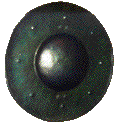
There is a large boss at the center of this
"buckler," a leather
shield of the style used in England
in the 13th-15th century. The diameter
of the entire buckler is about 14 inches. Much smaller bosses
encircle the large central one. See arms & armor, English
art, and omphalos.

An elaborate boss on a Tibetan door. The
ring attached to the boss serves as a handle with which to pull
the door open.
Also see atectonic, circle, convex, emboss, finial, mark, molding, relief, rondel or roundel or rondelle, rosette, rugosity, sheet metal, tenon, and texture.
botanical - A work of art whose subject is plant-life. This term is used more often to refer to a highly realistic image which could be viewed as a scientific illustration as much as it could be a still life picture.
Examples:

Byzantium, Constantinople, De materia medica by Dioskorides (folios 41 verso
- 42 recto), mid-14th century,
tempera on paper,
200 folios, 38.3 x 28 cm (15 1/8 x 11 inches). Seminario Vescovile,
Padua, Italy (codex 194). The first century CE
Greek physician and pharmacologist Dioskorides wrote the text that was copied into this volume about
1300 years later. It is a medical and pharmaceutical treatise
containing illustrations
and descriptions of plants,
along with advice about the drugs made from them. Good illustrations
long been important to the identification of plants. In this volume the pictures were produced first, after
which the text was written carefully around them. The plant on
the left is the delphinium, said to be a useful remedy for scorpion
bites. Facing it is a plant identified as "drakontia," an aid for breathing difficulties, cough, and diarrhea. Apparently knowledge in these scientific
disciplines had advanced very little over the intervening 1300
years.
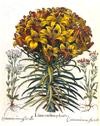
German, Libum cruentum polyanthos, c. 1613, copper-plate
engraving
with hand coloring, after
a drawing probably by Wolfgang Kilian of Augsburg, one of 367
plates from the Hortus Eystettensis, also known as the
"First Great Florilegium," edited by Basilius Besler.

Wang Hui (Chinese, 1632-1717), Three leaves from Landscapes and Flowers,
1672, ink and color on paper,
National Palace Museum, Taipei. See Chinese art, chop,
and Ching (Qing) dynasty.
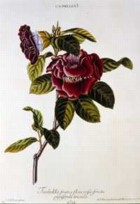
After
a painting by Georg Dionys Ehret (German, 1708-1770), Nuremberg,
Camellia
Tsabekki, frutex flore rofeo fructu pyriformi tricocco,
1740, copper-plate
engraving
with hand coloring, 1786, from the Hortus Nitidissimus,
printed by Adam Ludwig
Wirsing.

Zhang Yuan (Chinese), Autumn Flowers, 1948, ink and color on paper, Phoenix Art Museum, AZ. See Republican period.
Also see bestiary, bonsai, gyotaku, ikebana, nature, and still life.
bottega - The Italian word for studio or workshop. Often used to identify an object made in the studio of a master when his pupils' or assistants' work on it appears to dominate his own. (pr. bə-TAY-gə) Also see atelier.
boucharde - See bush hammer.
(pr. boo-SHAHRD)
bouleuterion - In ancient Greece, an assembly hall or council chamber.
(pr. boo-loo-TEE-ree-ən)
bourgeois and bourgeosie - People or values or behaviors typical of the middle class. All those who are bourgeois comprise a group called the "bourgeoisie." Most members of this group are executives and professionals. The upper middle class is known as the "haute bourgeoisie." These terms appear frequently in Marxist texts. When a less politically charged term is desireable, consider referring to people of middle- or upper-income levels.
(pr. boor-ZHWAH and BOOR-zhwah-ZEE)
Also see avant-garde, Fluxus, and Modernism.
bozzetto - An Italian term for a sculptured sketch made as a model, typically of wax or clay. This is the Italian equivalent to a maquette, a French term used more often by English speakers than is bozzetto.
https://inform.quest/_art